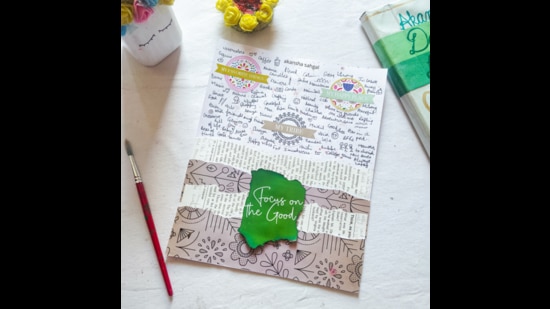Ctrl+S isn’t enough. Here’s why you should be scrapbooking
In a world of fleeting experiences, often marred by the taking of photographs that are rarely looked at again, a scrapbook acts like a cross between a photo album and a diary.
If a picture is worth a thousand words, one with a note attached is worth a thousand more. Just a date scribbled hurriedly on a keepsake makes a memory so much more poignant. But it takes special effort to create such memory troves in an age of pixels.

Your mobile phone is just one of many places where memories go to die. How often do you really scroll to the bottom of your Instagram page? And that’s where your college photos are. How often does Facebook remind you of a “memory from 7 years ago” that you’d clean forgotten about?
In a world of fleeting experiences, often marred by the taking of photographs that are rarely looked at again, a scrapbook acts like a cross between a photo album and a diary. It preserves images and bits of memorabilia — a museum pass, a seashell, a handwritten poem given as a gift. “Scrapbooks are in a way where your memories find a permanent home,” says Akansha Sahgal, 24, an MBA student from Delhi who makes customised ones as a hobby / side hustle.
Sahgal has been journaling and preserving photographs and keepsakes since she was a child. She has scrapbooks documenting family picnics, trips with her parents, festivals celebrated together. Four years ago she began making such scrapbooks for friends, to give out as gifts. She now makes them on request too, at prices ranging from ₹150 to ₹3,000. Often they’re chronicles of a single event such as a graduation ceremony. Some are crafted as collages and framed so they can hang on a wall.
When the first lockdown was enforced in 2020, Sahgal decided to document her own life too, to distract herself from the pandemic. “I wanted to gather happy memories,” she says. She’s preserved screenshots of virtual classes that were special to her and screenshots of some of the best comments from her DIY crafts YouTube channel, all of which she has printed out to add to her scrapbook.
“Scrapbooking can be comforting in times of distress. The very act of being absorbed in any creative activity that requires focus, is very calming for the brain,” says counselling psychologist Devanshi Jalan. “It allows one to live in the present moment, which is important. It can also serve as a link to past memories of love and joy, giving one hope.”
Sahgal divides her memories across three projects, personal life, academic milestones and memories with family. “Each keepsake stored in the book is accompanied by a handwritten note describing what I felt in that moment,” she says. Her college memory project contains her admission letters, college ID, printouts of emails from mentors, volunteer badges, tickets from field trips, a food coupon from the canteen.
“Most of us have a pretty fast-paced life. I don’t want to look back on my 20s and think, ‘Whoa! That went by fast!’” she says. And her reminders of 2020, she adds, will hopefully help her appreciate the good more. “It definitely is therapeutic too.”
For Alpna Kale, 41, a crafter from Goa, a memory scrapbook is emotion in tangible form. “It allows you to enjoy the same moment again and again, so it’s good for the heart,” she says.
Kale makes customised keepsake albums for events such as weddings, pregnancies, birthdays and anniversaries. A maternity memorabilia scrapbook contained an image of the pregnancy test, photos of the mother at different stages of the pregnancy, ultrasound scans, letters to the unborn baby, a lock of hair, hospital ID bracelets, baby footprints and handprints and so on.
Sometimes the client offers notes to go with the items; other times she leaves space for them to fill in the details in privacy. Her own personal keepsake collection includes letters from her husband, a piece of her son’s favourite toy as a toddler (a stuffed elephant) and certificates of merit from his school.
“These books also serve as a marker of our emotional growth,”’ says Sahgal. “Scrapbooking helps us document our personal growth in a very unusual manner.”





